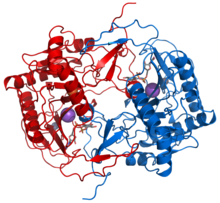- Protein dimer
-
In biochemistry, a dimer is a macromolecular complex formed by two, usually non-covalently bound, macromolecules like proteins or nucleic acids. It is a quaternary structure of a protein.
A homo-dimer would be formed by two identical molecules (process called homodimerization). A hetero-dimer would be formed by two different macromolecules (process called heterodimerization).
Most dimers in biochemistry are not connected by covalent bonds with the exception of disulfide bridges. An example of this would be the enzyme reverse transcriptase, which is made of two different amino acid chains.[1]
Some proteins contain specialized domains to ensure dimerization (dimerization domains).
Examples
- Antibodies
- Transcription factors
- Leucine zipper motif proteins
- Nuclear receptors
- 14-3-3 proteins
- G protein-coupled receptors
- G protein βγ-subunit dimer
- Kinesin
- Triosephosphateisomerase (TIM)
- Alcohol dehydrogenase
- Factor XI
- Factor XIII
- Toll-like receptor
- Fibrinogen
References
- ^ Nicolas Sluis-Cremer, Noureddine Hamamouch, Ana San Félix, Sonsoles Velázquez, Jan Balzarini, and María-José Camarasa (2006). "Structure-Activity Relationships of [2‘,5‘-Bis-O-(tert-butyldimethylsilyl)-ß-d-ribofuranosyl]- 3‘-spiro-5‘ ‘-(4‘ ‘-amino-1‘ ‘,2‘ ‘-oxathiole-2‘ ‘,2‘ ‘-dioxide)thymine Derivatives as Inhibitors of HIV-1 Reverse Transcriptase Dimerization". J. Med. Chem. 49 (16): 4834–4841. doi:10.1021/jm0604575. PMID 16884295.
See also
- Dimer
- Protein trimer
- ProtCID
Categories:- Proteins
- Biochemistry stubs
Wikimedia Foundation. 2010.

